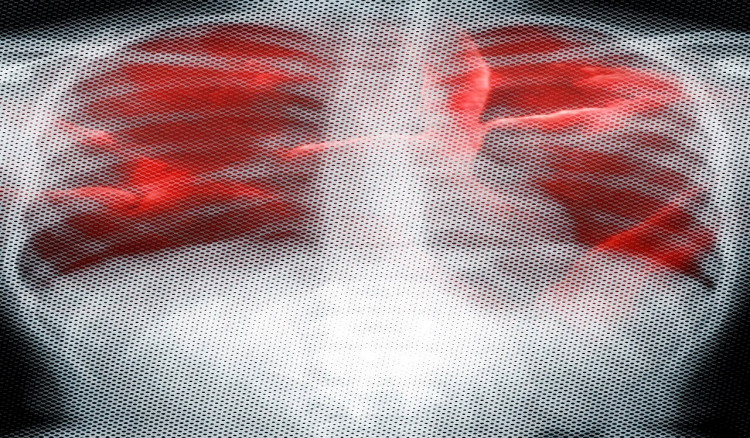
Pneumonia and Tuberculosis: Types, Symptoms and Treatment
Pneumonia is an acute inflammation of the lungs in which the tiny air sacs (alveoli) become so filled with fluid that breathing is affected.
Types of Pneumonia
One type of pneumonia familiar to most people is bacterial pneumonia, most often caused by the pneumococcus bacterium. This germ is usually present in healthy mouths and throats, and when the body’s resistance is lowered by colds, influenza or general poor health, pneumonia may develop.
Bacterial pneumonia was dangerous and often fatal before antibiotics such as penicillin and the sulfa compounds (Sulfonamides) came into use. Nowadays, if treatment is started early, the chances for full recovery are excellent.
Bacterial pneumonia may affect one or more of the lobes of the lung and is thus called lobar pneumonia. If both lungs are involved, the popular term is, ‘double pneumonia,’ the medical term is ‘bilateral pneumonia.’
In bronchopneumonia, the infection is not confined to one or more lobes of the lung but tends to be patchy, occurring in the alveoli surrounding the bronchial tubes.
A type of pneumonia more common in young adults than the bacterial type is called primary atypical pneumonia, or virus pneumonia. It is believed to be caused by viruses, but other microorganisms may also be responsible. The disease usually runs its course in about 10 days, but the person may feel weak and tired for a long time afterward. Treatment with antibiotic such as Tetracycline is sometimes found to be effective.
Pneumonia may also be caused by a collection of fluid in the lungs, foreign matter such a bits of food, or irritating chemicals. In persons undergoing surgery, care must be taken to remove mouth and nose secretions by suction so that they will not get into the lungs.
After consciousness returns, the postoperative patient is instructed to cough and perform breathing exercises.
Hypostatic pneumonia may occur in bedridden older people. Frequent changes of position will help to prevent the accumulation of fluids in the lungs. Oily nose drops and some household chemicals that have been accidentally inhaled can also bring on pneumonia.
Symptoms of Pneumonia
Pneumonia often strikes without much warning, and may be a complication of colds or influenza. The victim has a harsh, dry cough, sharp pains in the chest, fever, and often a chill. He finds it difficult to breathe and brings up rust-colored sputum containing blood or pus.
When the doctor taps the chest of a patient with lobar pneumonia, he hears dull thuds instead of the hollow sounds given off by healthy lungs. In bronchopneumonia the features may be much less severe. X-ray examination of the lungs helps the diagnosis.
Treatment of Pneumonia
Many cases can be treated at home. Severe cases are treated in the hospital where there are facilities for X-rays, laboratory tests and oxygen therapy. A patient may also need special nursing.
TUBERCULOSIS
Tuberculosis is an infectious communicable disease caused by Mycobacterium tuberculosis. It most frequently affects the lungs, but may also involve the larynx, the bones and joints, the skin, the lymph nodes, the intestines, the kidneys and the nervous system.
The disease is usually contracted by the inhalation of the bacilli into the lungs or by swallowing contaminated food. Droplets of sputum sprayed by an infected person during sneezing and coughing spread the germs directly to others and into the air.
The germs are also able to survive for long periods in dried sputum and in dust. Because of eradication of tuberculosis in cattle and widespread pasteurization of milk, transmission of the disease from infected cows is now rare in most countries of the world.
Types of Tuberculosis
The tuberculosis bacillus can infect almost any body tissue. Pulmonary tuberculosis is the most familiar and widespread form of the disease. In its early stages, pulmonary tuberculosis may exhibit no symptoms. That is why regular chest X-rays are important for everyone.
If the disease is found in its early stages, it is more easily cured. The symptoms of active pulmonary tuberculosis are loss of weight, weakness, coughing, blood-steaked sputum, and fever that tends to rise gradually during the day.
Miliary tuberculosis is a condition caused by the spread of large numbers of the bacilli to many parts of the body. This type of tuberculosis can affect the meninges (the membranes covering the brain and spinal cord), causing a serious infection called Tuberculosis Meningitis
Pott’s disease is tuberculosis of the spine and results in hunchback. It is now rare.
Tuberculosis Treatment
Many persons with tuberculosis can be treated at home, although a rest cure in a sanatorium may be recommended in some cases. There are several medicines used to control and cure the disease. The three chief ones being Streptomycin, Isoniazid (INH), and PAS (para-aminosalicylic acid.)
Tuberculosis Prevention
The best prevention is to maintain good health and to keep away from people who have tuberculosis. If you have a cough that persists for more than two or three weeks or if you feel tired all of the time and keep losing weight, get medical advice as soon as possible.
Never drink unpasteurized milk even if it is certified, because even healthy-looking cattle can transmit tuberculosis germs.
Yearly X-ray tests of the chest are no longer recommended by many doctors because of the fear that the rays may cause cancer. However, everyone should have a Tuberculin Test
Sources and References
Reader’s Digest Family Health Guide and Medical Encyclopedia
Bacterial Pneumonia in Older Adults by Oryan Henig and Keith S Kaye
Community Acquired Pneumonia: Assessment and Treatment by Caroline M Patterson and Michael R Loebinger
Mycobacterium Tuberculosis Metabolism by Gabriel Mashabela, Timothy de Wet and Digby Warner
Update in Tuberculosis/Pulmonary Infections 2015 by Serena Koenig and Jennifer Furin
Miliary Tuberculosis by Surendra Sharma and Alladi Mohan
The Diagnosis and Treatment of Tuberculosis by Isabelle Suarez, Jessica Rademacher et al
Pott disease: Vertebral Tuberculosis by Libardo Valencia Chicue, Indalecio Carboni Bisso and Marcos Las Heras






Share This Article: